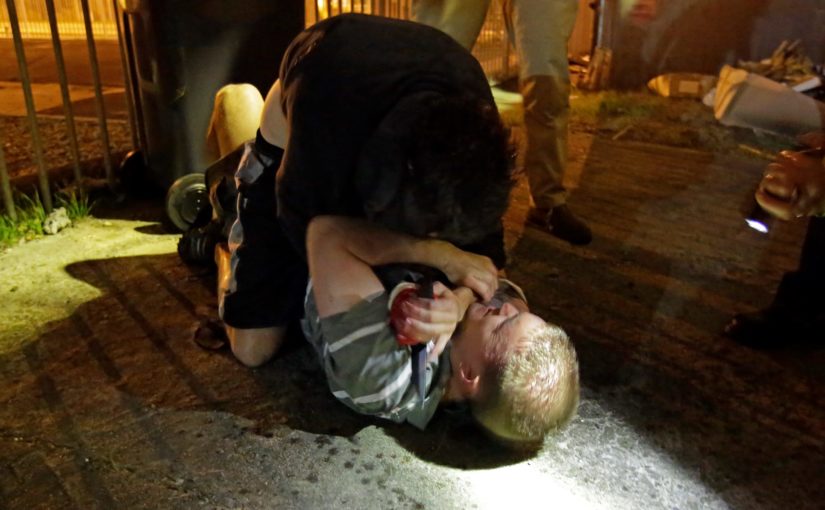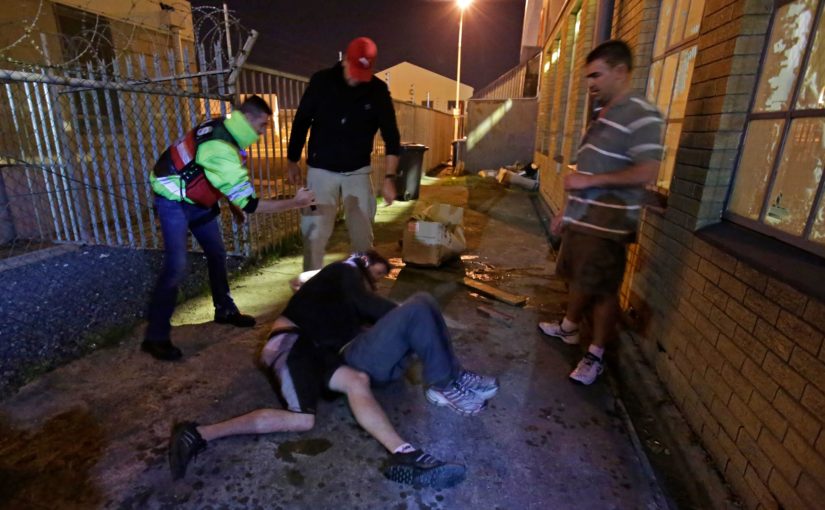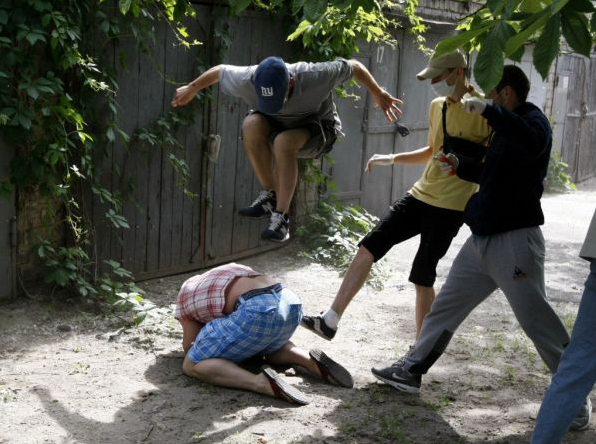We can set our triggers in two broad categories – proactive and reactive. Proactive is when we still have initiative. Reactive is when the aggressor has initiative. Confirmation Triggers fall into a proactive sphere. Opportunity Triggers and Necessity Triggers fall into a reactive sphere. When we are proactive we are acting. When we are reactive we are reacting. Meaning, when I notice a potential threat, I can flag him, decide or select certain triggers, and when I see them I act. Reactive means I have missed that evaluation process and I am now left responding to the confirmed threat’s initiative.
For example. Proactive is when I flag a pair of potential muggers before they attack. I can now set “if one of them pulls a knife I will do this” or “if one of them demands something from me” as a signal, trigger and response. A Confirmation Trigger was used. If I miss flagging the potential muggers and they jump me with a knife against my throat I have to kick into reactive mode. I can still run an IF THEN clause but now I will need to set Opportunity or Necessity Triggers. In terms of Opportunity it can be something like “if knife guy looks away I will do this.” In terms of Necessity it can be something like “if his buddy says kill him then I will do this.”
This breakdown of Confirmation, Opportunity and Necessity Triggers serves as a great training tool. It helps the learner to understand different tactics as well as wisdom in terms of when to deploy certain types of techniques. It also serves as an easy way to categorize the triggers into more memorable subsets.
Negative Influence Factors
All though there are others I am going to list the main negative influence factors in executing this Just Right Response.
1. Emotional State
If I can use an analogy that is still very active in our industry, this question has to do with whether the defender is functioning with his human (cognitive), monkey (emotional) or lizard (survival) brain. The decision making processes and goals differ in all three of these states. They form a linear line with human on the one side and lizard on the other. By implication, the more you go to the one side the less in control the other side is. Your emotional state thus influences your ability to make certain types of decisions.
The primary emotions we deal with in confrontations are fear and indignation or anger. The more scared or angry you get the more difficult it becomes to make good decisions. The problem with this is that the moment you become emotionally led you don’t always notice it. You think you are functioning normally but seldomly are. I’m not speaking about becoming or trying to be completely unemotional. It is normal, healthy, and can be beneficial for you to experience certain emotional and physiological changes under these conditions – I am talking about the fine line where you move from experiencing them to becoming led by them.
Going back to our thinking on a Just Right Response is becomes glaringly obvious that your emotional state can seriously influence this. If the emotions of fear or anger take over you might respond in any one of these: Too fast, too late, with too much force or with too little. Remember you observe and interpret data differently when emotional, you orient yourself differently to incoming data as well, so any decision you make is based on possibly faulty data. If your freeze response kicks in you might respond too late and with no force. If your fight response kicks in you possibly respond too fast and with too much force. The idea is to try and remain in control until it’s necessary or wise not to do so any more.
2. Accurate Mental Models
All of us store models of what threat signals look like in our subconscious. Your foundational models are based on simplistic data sets – an object travelling at your head really fast or a sudden shadow moving into your line of sight or a really loud bang. The reality however is that criminal attacks, depending on the type of criminal or attack, can send out very complex or minute signals that they are a threat. Also, the effective criminal works hard at actually hiding these already complex or minute signals. Understanding what valid threat signals LOOK or SOUND or FEEL or SMELL like is key to setting up a Just Right Response.
This is difficult without much experience and/or good training. The problem with much experience is the obvious and inherent dangers involved. Yes, we can learn first hand about the signals, the twitch we missed, the change in face colouration we missed, the slight shift in stance we missed, the hand ducking behind the back or into a pocket that we missed, the momentary change in his eyes and where they’re focusing, we can learn from these but we’re not guaranteed to walk away in one piece.
The problem with training is twofold. First of all it’s just whether you are training with these signals integrated or not in the first place – and whether you are being encouraged to explore, set and practice your triggers. Second of all it’s whether it’s being done in a realistic manner. Remember, you won’t just be dealing with the physical signals, but also with things like emotional state, presence, projection of power and intimidation, all of these change your brain’s ability to deal with the situation effectively as it provides more incoming data albeit at a more subconscious level.
3. Data Overload
Data overload can be approached from two different angles – time constraints and volume. Both of them create an overload effect. The first creates it due to the fact that your brain does not have enough time to deal with all of the incoming signals. The second creates it due to pure volume. There is simply too much happening at once for your brain to deal with it effectively.
Data overload is one of the key motivators for hammering effective situational awareness and range skills into our students. If you are able to pick up the development of a situation in a timely manner then you will have, by definition, more time to evaluate the incoming signals accurately. If you ingrain the simple, but not always so easy, habit of maintaining certain ranges from potential threats you immediately buffer your abilities substantially. The shorter the range the less time you have to evaluate and make decisions. The shorter the range the less you can see and less data you available to accurately evaluate and make decisions.
Training Tips
Signal and Trigger Discussions
Most of self defense training is geared towards the response side of this process. Consider stopping your class every now and again asking them about signals – and then about their individual triggers. Keep it short, maybe a minute or two. This will also help you pick up whether they actually have a good knowledge base of signals and a good idea of what would be good triggers for them as individuals.
Pick a Number
When doing striking combinations or pad work let the students pick a number between one and five. Let them pull of the combo when they hear that number. Then with variations in tempo, rhythm and volume count from one to five. The idea is that they only strike when they hear their number – and do so fast and effectively. Change it randomly switching over to the alphabet or different number strings.
Scenario Training
Include full blown scenario training into your classes. Teach your students how to realistically model certain signals when they are playing the role of the aggressor. Also, consider getting involved every now and again. Unexpected jump in on a scenario and really amp up the pressure. Or do something new. This will cause them to go either into an unplanned emotional or data overload state – or trip up their existing mental models.
*These are concepts and models that we, as in our training community, frequently use. This is the first time that I have attempted to pen them down upon Gary’s request. If any of the readers have any input or relevant research to share it would be much appreciated.




